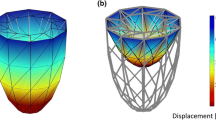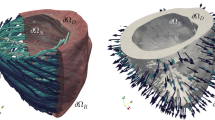Abstract
We modify and empirically study an adaptive multiscale model for simulating cardiac action potential propagation along a strand of cardiomyocytes. The model involves microscale partial differential equations posed over cells near the action potential upstroke and macroscale partial differential equations posed over the remainder of the tissue. An important advantage of the modified model of this paper is that, unlike our original model, it does not require perfect alignment between myocytes and the macroscale computational grid. We study the effects of gap-junctional coupling, ephaptic coupling, and macroscale grid spacing on the accuracy of the multiscale model. Our simulations reveal that the multiscale method accurately reproduces both the wavespeed and the waveform, including both upstroke and recovery, of fully microscale models. They also reveal that perfect alignment between myocytes and the macroscale grid is not necessary to reproduce the dynamics of a traveling action potential. Further, our simulations suggest that the macroscale grid spacing used in an adaptive multiscale model need not be much finer than the spatial width of an action potential. These results are demonstrated to hold under high, low, and zero gap-junctional coupling regimes.
Similar content being viewed by others
References
Bordas, R., Carpentieri, B., Fotia, G., Maggio, F., Nobes, R., Pitt-Francis, J., & Southern, J. (2009). Simulation of cardiac electrophysiology on next-generation high-performance computers. Philos. Trans. R. Soc. A, 367, 1951–1969.
Boron, W., & Boulpaep, E. (2005). Medical physiology. Philadelphia: Saunders.
Cherry, E., Greenside, H., & Henriquez, C. (2000). A space-time adaptive method for simulating complex cardiac dynamics. Phys. Rev. Lett., 84, 1343–1346.
Cherry, E., Greenside, H., & Henriquez, C. (2003). Efficient simulation of three-dimensional anisotropic cardiac tissue using an adaptive mesh refinement method. Chaos, 13, 853–865.
Colli Franzone, P., Deuflhard, P., Erdmann, B., Lang, J., & Pavarino, L. (2006). Adaptivity in space and time for reaction-diffusion systems in electrocardiology. SIAM J. Sci. Comput., 28, 942–962.
Copene, E., & Keener, J. (2008). Ephaptic coupling of cardiac cells through the junctional electric potential. J. Math. Biol., 57, 265–284.
Fenton, F., & Karma, A. (1998). Vortex dynamics in three-dimensional continuous myocardium with fiber rotation: Filament instability and fibrillation. Chaos, 8, 20–47.
Gutstein, D., Morley, G., Tamaddon, H., Vaidya, D., Schneider, M., Chen, J., Chien, K., Stuhlmann, H., & Fishman, G. (2001). Conduction slowing and sudden arrhythmic death in mice with cardiac-restricted inactivation of connexin43. Circ. Res., 88, 333–339.
Hand, P., & Griffith, B. (2010). Adaptive multiscale model for simulating cardiac conduction. Proc. Natl. Acad. Sci. USA, 107(33), 14603–14608.
Hand, P., & Peskin, C. (2010). Homogenization of an electrophysiological model for a strand of cardiac myocytes with gap-junctional and electric-field coupling. Bull. Math. Biol., 72, 1408–1424.
Hand, P., Griffith, B., & Peskin, C. (2009). Deriving macroscopic myocardial conductivities by homogenization of microscopic models. Bull. Math. Biol., 71, 1707–1726.
Keener, J., & Sneyd, J. (1998). Mathematical physiology. Berlin: Springer.
Keldermann, R., ten Tusscher, K., Nash, M., Bradley, C., Hren, R., Taggart, P., & Panfilov, A. (2009). A computational study of mother rotor VF in the human ventricles. Am. J. Physiol., Heart Circ. Physiol., 296(2), H370–H379.
Kucera, J., Rohr, S., & Rudy, Y. (2002). Localization of sodium channels in intercalated disks modulates cardiac conduction. Circ. Res., 91, 1176–1182.
Lin, J., & Keener, J. (2010). Modeling electrical activity of myocardial cells incorporating the effects of ephaptic coupling. Proc. Natl. Acad. Sci. USA, 107(49), 20935–20940.
Luo, C., & Rudy, Y. (1994). A dynamic model of the cardiac ventricular action potential. I. Simulations of ionic currents and concentration changes. Circ. Res., 74(6), 1071–1096.
Mori, Y., Fishman, G., & Peskin, C. (2008). Ephaptic conduction in a cardiac strand model with 3d electrodiffusion. Proc. Natl. Acad. Sci. USA, 105, 6463–6468.
Neu, J., & Krassowska, W. (1993). Homogenization of syncytial tissues. Crit. Rev. Biomed. Eng., 21, 137–199.
Peters, N., Green, C., Poole-Wilson, P., & Severs, N. (1993). Reduced content of connexin43 gap junctions in ventricular myocardium from hypertrophied and ischemic human hearts. Circulation, 88(3), 864–875.
Picone, J., Sperelakis, N., & Mann, J. (1991). Expanded model of the electric field hypothesis for propagation in cardiac muscle. Math. Comput. Model., 15, 13–35.
Ramasamy, L., & Sperelakis, N. (2007). Cable properties and propagation velocity in a long single chain of simulated myocardial cells. Theor. Biol. Med. Model., 4, 36.
Rohr, S. (2004). Role of gap junctions in the propagation of the cardiac action potential. Cardiovasc. Res., 62, 309–322.
Severs, N., Coppen, S., Dupont, E., Yeh, H., Ko, Y., & Matsushita, T. (2004). Gap junction alterations in human cardiac disease. Cardiovasc. Res., 62(2), 368–377.
Severs, N., Bruce, A., Dupont, E., & Rothery, S. (2008). Remodelling of gap junctions and connexin expression in diseased myocardium. Cardiovasc. Res., 80(1), 9–19.
Smith, J., Green, C., Peters, N., Rothery, S., & Severs, N. J. (1991). Altered patterns of gap junction distribution in ischemic heart disease. An immunohistochemical study of human myocardium using laser scanning confocal microscopy. Am. J. Pathol., 139(4), 801–821.
Sperelakis, N., & Mann, J. (1977). Evaluation of electric field changes in the cleft between excitable cells. J. Theor. Biol., 64, 71–96.
Yao, J., Gutstein, D., Liu, F., Fishman, G., & Wit, A. (2003). Cell coupling between ventricular myocyte pairs from connexin43-deficient murine hearts. Circ. Res., 93(8), 736–743.
Author information
Authors and Affiliations
Corresponding author
Rights and permissions
About this article
Cite this article
Hand, P.E., Griffith, B.E. Empirical Study of an Adaptive Multiscale Model for Simulating Cardiac Conduction. Bull Math Biol 73, 3071–3089 (2011). https://doi.org/10.1007/s11538-011-9661-5
Received:
Accepted:
Published:
Issue Date:
DOI: https://doi.org/10.1007/s11538-011-9661-5




